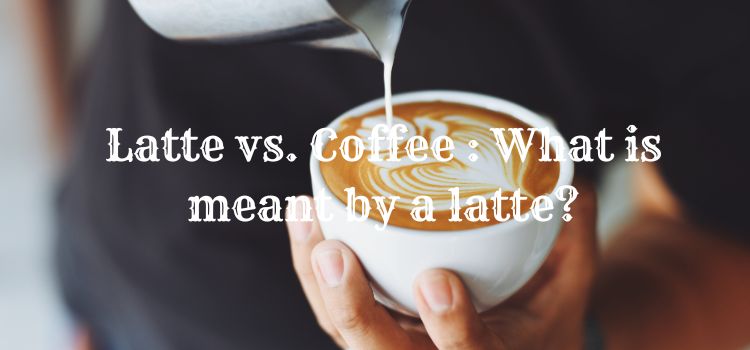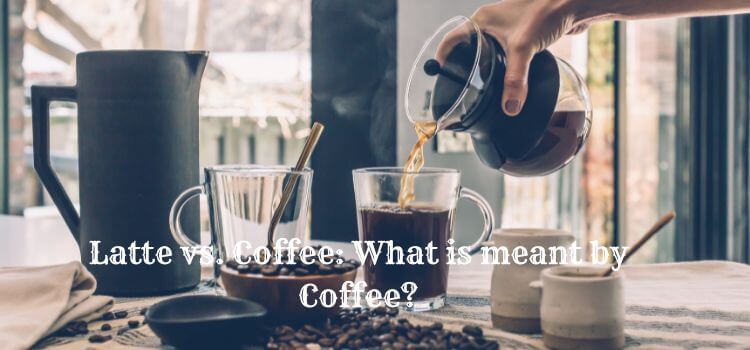As an Amazon Associate, I earn from qualifying purchases.
As an Amazon Associate, I earn from qualifying purchases
You can almost always count on seeing Coffee and lattes on the menu at your neighborhood cafe.
Then again, aren’t they both caffeine-based?
If so, why bother with a latte when you can have Coffee?

Okay, I’ll explain it in plain English because I used to be a barista. First, we’ll go over the basics of each of these beverages.
What exactly does a latte mean?
The creamy coffee drink known as a latte has its origins in Italy.
The Italian word for Coffee with milk, café latte, is the formal name of the drink, though we all know it as a latte.
Rich espresso and (often) whole milk make up a caffe latte. With a hint of bitterness, the drink finishes with a rich, velvety flavor.
Nowadays, Many baristas add syrups to conventional lattes consisting of espresso and steaming milk.
Syrups not only sweeten the drink, but they also impart distinctive flavors that set it apart from the crowd.

The most remarkable thing about lattes is the graphics that baristas can make on top of them using specific milk-pouring techniques.
The milk is delicately poured into the espresso crema in a pattern-making motion.
What comes out of it is called “latte art” informally.
Nowadays, you may have a latte in various forms; iced lattes are among the most popular. It’s like iced Coffee, except that espresso is used instead of freshly brewed Coffee.
What is meant by coffee?
A blend of roasted coffee beans, water, and sugar, Coffee is the national drink of the United States.
You may make Coffee in a variety of ways. Some time-honored methods for bottling beer are:
Choka Pot,
Chemex,
Turkish Coffee,
V60,
Aeropress
Although many more brewing systems are available, these are among the most common.
It is conventional to brew Coffee when it is hot, but it is also possible to chill it. A beverage made in this manner is called iced Coffee.

You may even sweeten your Coffee with sugar and cream.
By doing so, you may personalize your beverage to your liking!
Latte vs Coffee: What is the Difference?
Now that you have a basic understanding of Coffee and lattes let’s get into the nitty-gritty.
These beverages are distinct from one another, even if they share the ingredients of coffee beans.
Let’s compare and contrast a few critical features of Coffee and lattes.
Ingredients:
The bare minimum for brewing coffee is water and coffee beans.
While milk and sugar are optional additions, they aren’t necessary for a traditional cup of Coffee.
Grind the beans coarsely for your Coffee. Temperate or frigid water will do.
Finely ground Coffee, heated water, and frothed milk make a latte.
Adding sugar or syrups is always an option. This isn’t your average latte, either.
Both beverages are easy to make. You can quickly whip these up in your kitchen with only a few simple ingredients.
The Art of Brewing:
An espresso machine is required for the brewing of lattes. This machine is used for a robust and velvety espresso shot for your latte.
About 7 grams of finely ground Coffee will be needed to prepare one shot of espresso for your latte. A total of fourteen grams of coffee grounds will yield two double shots.
It all starts with the espresso shots when you want to make a latte. In a cup, place them, and set them away.
Steaming and heating the milk is the next step. When you’ve made it, top your espresso shots with a delicate milk foam.
I’m done! A delicious latte is ready in no time at all.
How to prepare Coffee is the next topic we should cover.
One of the many methods for preparing Coffee is to combine instant coffee powder with hot water.
Making Coffee was challenging; you only need your preferred coffee machine, some coffee grounds, and water.
A percolation technique, such as a Chemex or French press, is my preferred method.
Percolating, or flavor developing, Coffee usually takes around three minutes.
Just pour the Coffee into a mug when the timer goes off, and you’re ready!
Factor of Tasting:
Coffee tends to be harsh and intense in flavor, whereas lattes tend to be mild and creamy.
Espresso, usually a dark, oily roast, is used to make lattes. They taste rich and robust.
But the natural sugars in milk make for a delicious drink when you mix them with them.
The result is Coffee that is milder and easier on the palate.
In contrast, the flavor of brewed Coffee is highly sensitive to the bean variety.
Although roast, bean type, and brewing method can all contribute to subtle variations, brewed Coffee is typically black and bitter.

Arabica or Robusta beans are the most common types used to make Coffee. Arabica beans have a firm acidity and flavor, but Robusta beans are black and bitter.
Arabica beans, which have a high acidity level and impart a more robust flavor to Coffee, are the most often used beans for making Coffee.
There are three roast levels to select from: light, medium, or dark. Roasts can range from light and lemony to balanced dark and smokey.
Technique of Serving:
There is also a serving difference between Coffee and lattes.
Lattes are always served in cups to start. Usually, a cute design in the milk decorates the drink.
You’ll frequently encounter patterns with hearts, leaves, and flowers.
Conversely, Coffee that has been made can be consumed straight from the maker or in a mug.
For example, you will nearly always receive the French press or Chemex if you order a coffee.
In contrast, you’ll receive a mug when you purchase a cup of drip-brew Coffee.
Strength
One distinguishing factor between a latte and a cup of Coffee is their disparity in strength.
Due to the substitution of brewed Coffee with espresso in lattes, the caffeine content in the beverage is considerably reduced.
An espresso shot typically includes approximately 63mg of caffeine. Conversely, a cup of brewed Coffee typically has about 100mg.
Despite its robust flavor, espresso delivers a milder impact.
Consequently, the latte becomes less potent than a cup of Coffee.
Nutritional value:
The number of calories I consume is something I constantly keep in mind whenever I visit a coffee shop.
You still need to be aware of the calorie content of both regular lattes and cups of Coffee, even though both contain only a few.
Ground coffee and hot water are basCoffeeredients forCoffee of Coffee. That’s all there is to it.
So, each cup only has approximately five calories!
In contrast, the foamed milk used to make lattes is a natural source of carbohydrates and fats. Consequently, it tends to be higher in calories.
On average, there are around 200 calories in a latte.
And that’s not horrible either when put in perspective. The calorie count will increase if you sweeten it with syrups or sugar.
FAQ:
Please clarify the distinction between CoffCoffee lattes if you’re still confused.
Lattes and CoffCoffee are two different beverages; however, here’s a brief FAQ with additional details.
Does a latte have more caffeine than Coffee?
The caffeine content in lattes is lower than that of CoffCoffeeere are approximately 75 milligrams of caffeine in a latte, compared to about 100 milligrams in a standard cup of CoffCoffeecause it lacks milk; brewed CoffCoffee has a more robust flavor than lattes.
Is a cappuccino better for you than a latte?
In contrast to lattes, which also include milk, black CoffCoffeet contains water. Consequently, CoffCoffee is typically a better choice than a latte because it has fewer calories and less fat.
Will everyday coffee work in a latte?
Lattes call for just a shot or two of espresso. The espresso makes for a more robust cup, CoffCoffee, which goes nicely with the latte’s milk. Caffe Misto is the real name for what you’ll get if you try to make a latte with brewed CoffCoffee
Last Remarks:
A brief overview of the distinctions between CoffCoffee lattes is thus concluded.
Both beverages are great for a quick pick-me-up in the morning or afternoon and are brewed with CoffCoffee. One of these cocktails will become your favorite, no matter your choice.
We may also accommodate your request for an alternative latte flavor. For more information on lattes, have a look at this guide.
What did you think of this post?
Amazon and the Amazon logo are trademarks of Amazon.com, Inc. or its affiliates.
Leave a Reply